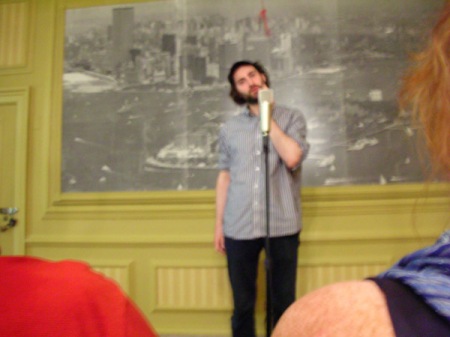
Performance view, Photo by CAD
As mentioned in the previous post, Tris Vonna-Michell’s performance at Governor’s Island was enthralling, and in its own way, virtuoso (*gasp*). The setting was thus: a musty room in one of the many historical buildings on the island. The exterior hallways are covered with history murals depicting iconic events in American history. Inside, rows of chairs face towards a lone microphone (recording), flanked by a large aerial photo over Governor’s Island and Lower Manhattan. The Twin Towers, the photographic quality, all bespeak the 1960s or early 70s. Clearly exhausted in what ended up being his last performance of the weekend (he decided to forgo the final one), Vonna-Michell endeavored to describe the circuitous events ¬that led him to that very place, all beginning, unlikely enough in Japan in the early 2000s, when it seems the artist was traveling and low on funds. Straightforward seeming enough, except for the artist’s self-imposed time restriction of 10 minutes given to the task. This time limit is elemental to the project, and gives his storytelling a particular urgency. Part of the meta-narrative is an admission that he has yet to get to finish explaining through any of the previous performances, so he will have to try to go even faster.
The result is a compression of language, often incoherent as narrative to the audience. Words become dislocated from grammatical structures, taking on an almost hieroglyphic function in the litany of places, brands, historical events that come flowing out as though a stopper has been removed: at the same time releasing only nouns and the occasional verb, filtering out all prepositions, adjectives, articles… Repetition is the norm, and after seven minutes, a “sentence” like “Toblerone, Koji” not only makes sense and has some sort of context (temporal as much as narrative), it is absolutely hilarious. Or, apologetically, Pardonnez mon mauvais francais.” All of this travels through, in no particular order, Hiroshima, London, Berlin, Paris, the Stasi, Detroit, the Berlin train station, which of course can’t get you to Tokyo… Autobiographical and historiographic information are part of a single constant stream. Martin Herbert describes Vonna-Michell’s performances as
The possibility of knowledge emerging from the intersections of personal experience, history, and coincidence… a dazzlingly fast, borderline-impenetrable monologue recounting his quest, edited or expanded on the fly… semi-improvised recitations…
Vonna-Michell foregrounds his performance as an act of storytelling, in which each “telling” is a conflict with the act of integrating what is relevant within the limits of language and narrative. Every word becomes a calculation of what is essential, more concerned with the evocative than the factual. Gestures and a sort of sign language evolve to accompany the story; the lanky artist sways around the microphone like a dancer, every movement fluid as though conducted by his words.

Action shot, too quick even for the camera. Photo by CAD.
The performance ended, predictably enough, with Vonna-Michell apologizing because he has run out of time, and of course his tale is nowhere near Governor’s Island. When I saw him later that afternoon as we were exploring other works included in Plot 09, the artist explained that it seemed appropriate that the commission was incomplete. Part of this was pragmatic: during the performance, and again in personal conversation afterwards, he admitted that the curator’s proposal of something like 10 performances in two days was a bit absurd considering he had done just four such performances in the previous year. But there was also an appropriate poetics to the cancelled final performance, suggesting a synecdochal relationship to the failure of each of the individual monologues to complete a story. Embodying a corollary relationship to larger mechanisms of history in process, what constitutes Vonna-Michell’s oeuvre remains a series of open-ended archives.
I highly recommend Martin Herbert’s introduction to Vonna-Michell’s work from the January issue of Artforum (Log-In required.). As I re-read it I found it dealt with almost all of the major ideas that I brought away from the Governor’s Island performance. Herbert points out the archival aspect of TVM’s project as well—certainly a theme of interest to me personally.
Also: X-Initiative’s Phase 2 opens today, and includes solo shows by Vonna-Michell, Keren Cytter and Luke Fowler. Each occupies an entire floor of the old Dia building.
On the one hand I am very excited about this, as what I have seen of each of these artists is impressive and makes me want to experience more for myself. But there is also a bit of the business as usual here that the cynical side of me wants to question. The press release goes to great lengths to point out that each of these artists has been included in major international biennial-type affairs. They’ve each received notable awards, received profiles in the major art magazines, etc.
When I first saw the line-up, my first thought was, “Oh—they were all in Younger than Jesus.” Granted, a full floor allows a very different presentation than the limited spaces allotted each at the New Museum, but when you remember that X Initiative curatorial director Cecilia Alemani is also the partner of Massimiliano Gioni (one of the curators of YTJ)… well, I’m ambivalent. Granted, X Initiative is working from a sort of ad-hoc model, with limited planning timelines and exhibition budgets, so it makes sense to present exhibitions heavy on ephemerality and video (low shipping costs). So I while I am excited to see the exhibitions and the potentially ambitious presentations from each artist, I do wish that X would take a greater risk.
Tags: Governors Island, History, Martin Herbert, Tris Vonna-Michell, X-Initiative
July 24, 2009 at 12:02 PM |
I also have some original artwork for sale. Please visit my web page for details and pricing.